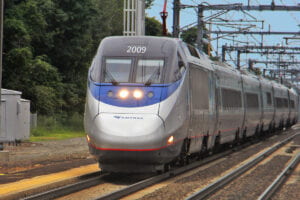A bold but necessary route for high-speed rail in the US.

For too long, climate change paralysis has plagued our country. The United States has been staring down the barrel of climate change without meaningful action for the past 16 years since An Inconvenient Truth propelled the crisis into the national dialogue.
Apart from the few electric and hybrid vehicles on the road now, our transportation industry- the leading contributor of greenhouse gas emissions– looks the same. Planes and passenger vehicles dominate the United States’ transportation system, lagging behind European and Asian countries, which have had high-speed passenger rail systems for decades.
Nations that invest in high-speed rail infrastructure have significantly lower transportation emissions per capita. The United States emits almost three times more per capita than the European Union, over three times more per capita than Japan, and over eight times more per capita than China.
This is no shock considering high-speed rail is a much more environmentally friendly mode of transportation. A study by Britain’s Department of Business, Energy and Industrial Strategy claims Eurostar high-speed rail emits 27 times less carbon dioxide than passenger vehicles and 21 times less than domestic air travel.
16 years since climate change became a major political issue, why are our main modes of transportation emitting far more carbon dioxide than they need to? Because we have failed to adequately fund and focus our high-speed rail efforts.
The 2021 Bipartisan Infrastructure Law gives about $100 billion in funding over the next five years to the Federal Rail Administration for the entire country. This might seem like a lot but it is just shy of the funds it would take to bring high-speed rail to only the Northeast Corridor, connecting cities from Boston to D.C..
Suppose we focused our funds on one project – the Northeast Corridor. This region’s metropolitan hubs, Boston, New York, Philadelphia and D.C., are all within a potential 1.5-hour high-speed train ride from each other. On top of that, according to the American Public Transportation Association 75 percent of those who live in the Northeast are likely to use high-speed rail, more than anywhere else in the country.
High-speed rail would not replace all passenger car and air travel between these cities. But what if it replaced only 75 percent of just the short haul flights, which serve a role similar to that of high speed rail, in the Northeast?
Based on a sample of a typical week of short haul flights between these four Northeastern cities, we could save over 1.5 trillion grams of carbon dioxide emissions in a year just by replacing 75% of those flights with high-speed rail [1].
Even though we do need a national high-speed rail system, I argue that we should focus national rail funding on just one corridor. While that may sound counterintuitive, we need to be realistic given the scope and price tag of building this infrastructure. It makes sense to focus our funds on one impactful project like the Northeast Corridor. It could serve as a proof of concept to spur future rail systems and reliably connect a region that contributes 20% of US GDP. It would also have the most riders and serve the most states compared to any other potential rail project in the country.
Dividing the precious funds we currently have among piecemeal, incremental projects ensures we will never experience the real benefits high-speed rail has to offer. We need bold strokes by the Department of Transportation to jump start the fight against climate change and spur economic growth throughout the region and the country. We have $100 billion of rail funds to use wisely. Invest it all in one project. Let us actually have a high-speed rail service that we can experience and inspire future projects across the US.
Notes: [1] Using Google Flights, I compiled a list of all flights from the major Northeastern cities to one another during the week of Oct. 24th to Oct. 30th. When the number of flights was larger than 15, I randomly selected a sample of 10, used plane manufacturers’ websites to calculate average full flight capacity, multiplied it by miles between cities to arrive at passenger miles, and multiplied again by CO2 emissions per passenger mile to arrive at total CO2 emissions.
You can reach the author of this piece, Paul Wennberg, at: pew7848@nyu.edu
You can reach the editor of this piece, Calley Wang, at: csw9856@nyu.edu